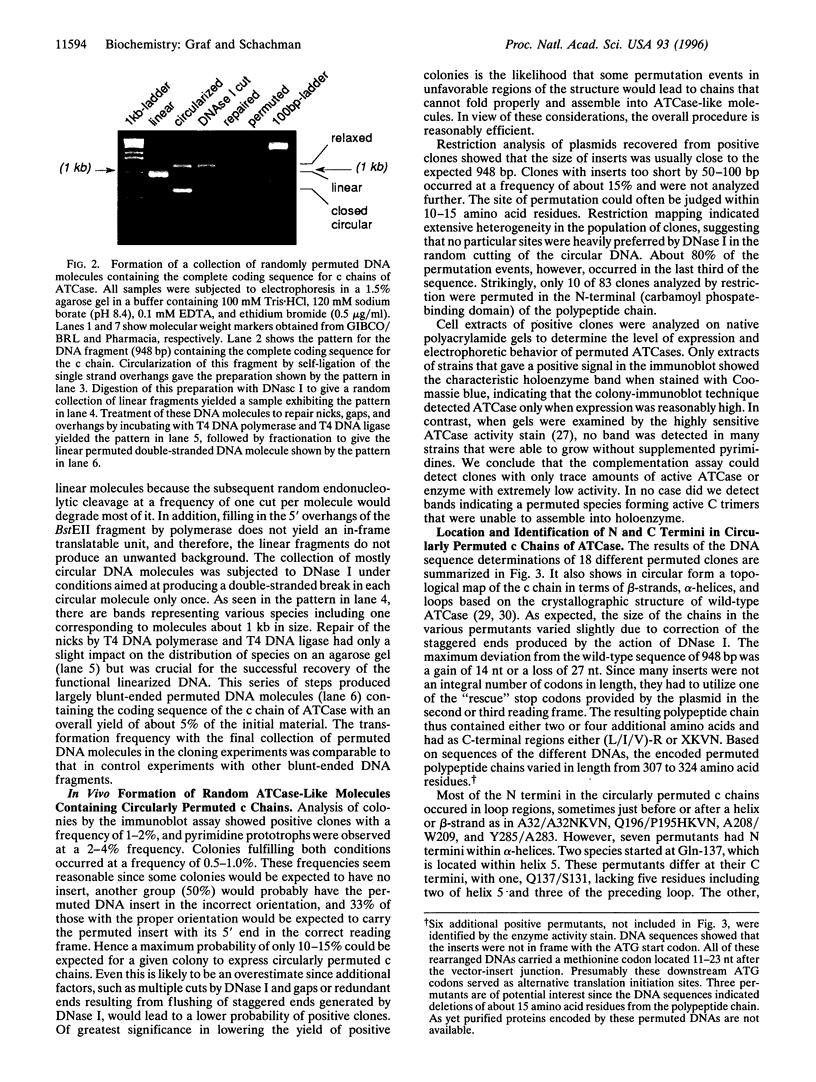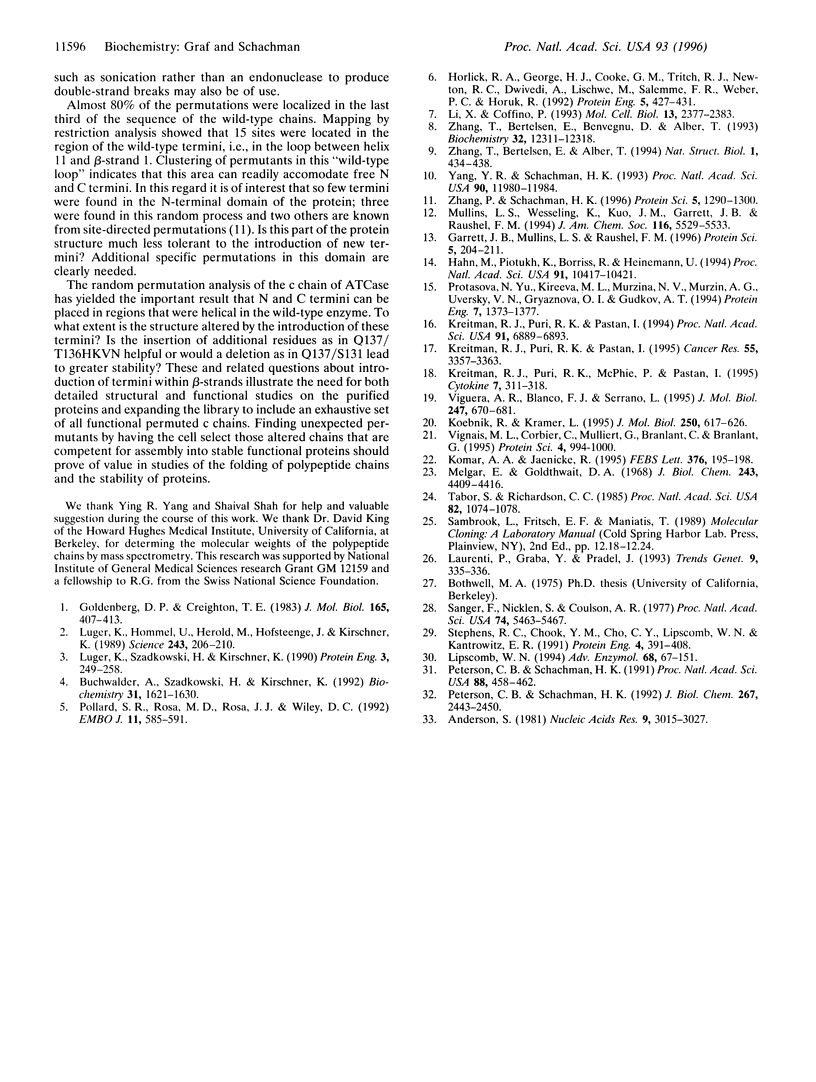Abstract
Recent studies on proteins whose N and C termini are in close proximity have demonstrated that folding of polypeptide chains and assembly of oligomers can be accomplished with circularly permuted chains. As yet no methodical study has been conducted to determine how extensively new termini can be introduced and where such termini cannot be tolerated. We have devised a procedure to generate random circular permutations of the catalytic chains of Escherichia coli aspartate transcarbamoylase (ATCase; EC 2.1.3.2) and to select clones that produce active or stable holoenzyme containing permuted chains. A tandem gene construct was made, based on the desired linkage between amino acid residues in the C- and N-terminal regions of the polypeptide chain, and this DNA was treated with a suitable restriction enzyme to yield a fragment containing the rearranged coding sequence for the chain. Circularization achieved with DNA ligase, followed by linearization at random with DNase I, and incorporation of the linearized, repaired, blunt-ended, rearranged genes into a suitable plasmid permitted the expression of randomly permuted polypeptide chains. The plasmid with appropriate stop codons also contained pyrI, the gene encoding the regulatory chain of ATCase. Colonies expressing detectable amounts of ATCase-like molecules containing permuted catalytic chains were identified by an immunoblot technique or by their ability to grow in the absence of pyrimidines in the growth medium. Sequencing of positive clones revealed a variety of novel circular permutations. Some had N and C termini within helices of the wild-type enzyme as well as deletions and insertions. Permutations were concentrated in the C-terminal domain and only few were detected in the N-terminal domain. The technique, which is adaptable generally to proteins whose N and C termini are near each other, can be of value in relating in vivo folding of nascent, growing polypeptide chains to in vitro renaturation of complete chains and determining the role of protein sequence in folding kinetics.
Full text
PDF





Images in this article
Selected References
These references are in PubMed. This may not be the complete list of references from this article.
- Anderson S. Shotgun DNA sequencing using cloned DNase I-generated fragments. Nucleic Acids Res. 1981 Jul 10;9(13):3015–3027. doi: 10.1093/nar/9.13.3015. [DOI] [PMC free article] [PubMed] [Google Scholar]
- Buchwalder A., Szadkowski H., Kirschner K. A fully active variant of dihydrofolate reductase with a circularly permuted sequence. Biochemistry. 1992 Feb 18;31(6):1621–1630. doi: 10.1021/bi00121a006. [DOI] [PubMed] [Google Scholar]
- Garrett J. B., Mullins L. S., Raushel F. M. Are turns required for the folding of ribonuclease T1? Protein Sci. 1996 Feb;5(2):204–211. doi: 10.1002/pro.5560050203. [DOI] [PMC free article] [PubMed] [Google Scholar]
- Goldenberg D. P., Creighton T. E. Circular and circularly permuted forms of bovine pancreatic trypsin inhibitor. J Mol Biol. 1983 Apr 5;165(2):407–413. doi: 10.1016/s0022-2836(83)80265-4. [DOI] [PubMed] [Google Scholar]
- Hahn M., Piotukh K., Borriss R., Heinemann U. Native-like in vivo folding of a circularly permuted jellyroll protein shown by crystal structure analysis. Proc Natl Acad Sci U S A. 1994 Oct 25;91(22):10417–10421. doi: 10.1073/pnas.91.22.10417. [DOI] [PMC free article] [PubMed] [Google Scholar]
- Horlick R. A., George H. J., Cooke G. M., Tritch R. J., Newton R. C., Dwivedi A., Lischwe M., Salemme F. R., Weber P. C., Horuk R. Permuteins of interleukin 1 beta--a simplified approach for the construction of permutated proteins having new termini. Protein Eng. 1992 Jul;5(5):427–431. doi: 10.1093/protein/5.5.427. [DOI] [PubMed] [Google Scholar]
- Koebnik R., Krämer L. Membrane assembly of circularly permuted variants of the E. coli outer membrane protein OmpA. J Mol Biol. 1995 Jul 28;250(5):617–626. doi: 10.1006/jmbi.1995.0403. [DOI] [PubMed] [Google Scholar]
- Komar A. A., Jaenicke R. Kinetics of translation of gamma B crystallin and its circularly permutated variant in an in vitro cell-free system: possible relations to codon distribution and protein folding. FEBS Lett. 1995 Dec 4;376(3):195–198. doi: 10.1016/0014-5793(95)01275-0. [DOI] [PubMed] [Google Scholar]
- Kreitman R. J., Puri R. K., McPhie P., Pastan I. Circularly permuted interleukin 4 retains proliferative and binding activity. Cytokine. 1995 May;7(4):311–318. doi: 10.1006/cyto.1995.0039. [DOI] [PubMed] [Google Scholar]
- Kreitman R. J., Puri R. K., Pastan I. A circularly permuted recombinant interleukin 4 toxin with increased activity. Proc Natl Acad Sci U S A. 1994 Jul 19;91(15):6889–6893. doi: 10.1073/pnas.91.15.6889. [DOI] [PMC free article] [PubMed] [Google Scholar]
- Kreitman R. J., Puri R. K., Pastan I. Increased antitumor activity of a circularly permuted interleukin 4-toxin in mice with interleukin 4 receptor-bearing human carcinoma. Cancer Res. 1995 Aug 1;55(15):3357–3363. [PubMed] [Google Scholar]
- Laurenti P., Graba Y., Pradel J. A quick method for immunoscreening recombinant bacterial colonies. Trends Genet. 1993 Oct;9(10):335–336. doi: 10.1016/0168-9525(93)90023-b. [DOI] [PubMed] [Google Scholar]
- Li X., Coffino P. Degradation of ornithine decarboxylase: exposure of the C-terminal target by a polyamine-inducible inhibitory protein. Mol Cell Biol. 1993 Apr;13(4):2377–2383. doi: 10.1128/mcb.13.4.2377. [DOI] [PMC free article] [PubMed] [Google Scholar]
- Luger K., Hommel U., Herold M., Hofsteenge J., Kirschner K. Correct folding of circularly permuted variants of a beta alpha barrel enzyme in vivo. Science. 1989 Jan 13;243(4888):206–210. doi: 10.1126/science.2643160. [DOI] [PubMed] [Google Scholar]
- Luger K., Szadkowski H., Kirschner K. An 8-fold beta alpha barrel protein with redundant folding possibilities. Protein Eng. 1990 Mar;3(4):249–258. doi: 10.1093/protein/3.4.249. [DOI] [PubMed] [Google Scholar]
- Melgar E., Goldthwait D. A. Deoxyribonucleic acid nucleases. II. The effects of metals on the mechanism of action of deoxyribonuclease I. J Biol Chem. 1968 Sep 10;243(17):4409–4416. [PubMed] [Google Scholar]
- Peterson C. B., Schachman H. K. Long range effects of amino acid substitutions in the catalytic chain of aspartate transcarbamoylase. Localized replacements in the carboxyl-terminal alpha-helix cause marked alterations in allosteric properties and intersubunit interactions. J Biol Chem. 1992 Feb 5;267(4):2443–2450. [PubMed] [Google Scholar]
- Peterson C. B., Schachman H. K. Role of a carboxyl-terminal helix in the assembly, interchain interactions, and stability of aspartate transcarbamoylase. Proc Natl Acad Sci U S A. 1991 Jan 15;88(2):458–462. doi: 10.1073/pnas.88.2.458. [DOI] [PMC free article] [PubMed] [Google Scholar]
- Pollard S. R., Rosa M. D., Rosa J. J., Wiley D. C. Truncated variants of gp120 bind CD4 with high affinity and suggest a minimum CD4 binding region. EMBO J. 1992 Feb;11(2):585–591. doi: 10.1002/j.1460-2075.1992.tb05090.x. [DOI] [PMC free article] [PubMed] [Google Scholar]
- Protasova NYu, Kireeva M. L., Murzina N. V., Murzin A. G., Uversky V. N., Gryaznova O. I., Gudkov A. T. Circularly permuted dihydrofolate reductase of E. coli has functional activity and a destabilized tertiary structure. Protein Eng. 1994 Nov;7(11):1373–1377. doi: 10.1093/protein/7.11.1373. [DOI] [PubMed] [Google Scholar]
- Sanger F., Nicklen S., Coulson A. R. DNA sequencing with chain-terminating inhibitors. Proc Natl Acad Sci U S A. 1977 Dec;74(12):5463–5467. doi: 10.1073/pnas.74.12.5463. [DOI] [PMC free article] [PubMed] [Google Scholar]
- Stevens R. C., Chook Y. M., Cho C. Y., Lipscomb W. N., Kantrowitz E. R. Escherichia coli aspartate carbamoyltransferase: the probing of crystal structure analysis via site-specific mutagenesis. Protein Eng. 1991 Apr;4(4):391–408. doi: 10.1093/protein/4.4.391. [DOI] [PubMed] [Google Scholar]
- Tabor S., Richardson C. C. A bacteriophage T7 RNA polymerase/promoter system for controlled exclusive expression of specific genes. Proc Natl Acad Sci U S A. 1985 Feb;82(4):1074–1078. doi: 10.1073/pnas.82.4.1074. [DOI] [PMC free article] [PubMed] [Google Scholar]
- Vignais M. L., Corbier C., Mulliert G., Branlant C., Branlant G. Circular permutation within the coenzyme binding domain of the tetrameric glyceraldehyde-3-phosphate dehydrogenase from Bacillus stearothermophilus. Protein Sci. 1995 May;4(5):994–1000. doi: 10.1002/pro.5560040519. [DOI] [PMC free article] [PubMed] [Google Scholar]
- Viguera A. R., Blanco F. J., Serrano L. The order of secondary structure elements does not determine the structure of a protein but does affect its folding kinetics. J Mol Biol. 1995 Apr 7;247(4):670–681. doi: 10.1006/jmbi.1994.0171. [DOI] [PubMed] [Google Scholar]
- Yang Y. R., Schachman H. K. Aspartate transcarbamoylase containing circularly permuted catalytic polypeptide chains. Proc Natl Acad Sci U S A. 1993 Dec 15;90(24):11980–11984. doi: 10.1073/pnas.90.24.11980. [DOI] [PMC free article] [PubMed] [Google Scholar]
- Zhang P., Schachman H. K. In vivo formation of allosteric aspartate transcarbamoylase containing circularly permuted catalytic polypeptide chains: implications for protein folding and assembly. Protein Sci. 1996 Jul;5(7):1290–1300. doi: 10.1002/pro.5560050708. [DOI] [PMC free article] [PubMed] [Google Scholar]
- Zhang T., Bertelsen E., Alber T. Entropic effects of disulphide bonds on protein stability. Nat Struct Biol. 1994 Jul;1(7):434–438. doi: 10.1038/nsb0794-434. [DOI] [PubMed] [Google Scholar]
- Zhang T., Bertelsen E., Benvegnu D., Alber T. Circular permutation of T4 lysozyme. Biochemistry. 1993 Nov 23;32(46):12311–12318. doi: 10.1021/bi00097a006. [DOI] [PubMed] [Google Scholar]



